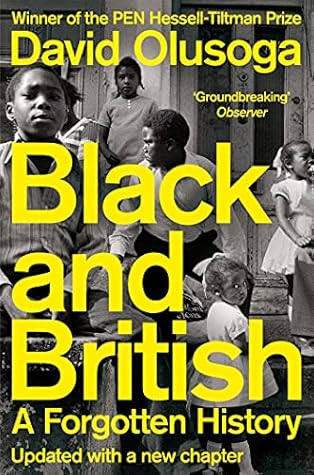More on this book
Community
Kindle Notes & Highlights
Thanks to their work it is today well understood that people of African descent have been present in Britain since the third century, and there have been black ‘communities’ of sorts since the 1500s.
A history largely shaped by migration – both forced and voluntary – is disproportionately male.
At the end of the previous war there had been around twenty thousand black people in Britain. Before that Britain had been home to small communities of black Edwardians, black Victorians and a larger population of black Georgians.
The guinea was so named because it was made from gold bought on Africa’s Guinea Coast. On one side of the coins was the head of the King and on the other the symbol of an elephant and castle – the trademark of the Royal African Company.
Like the story of the South Sea Bubble, Carlyle’s description of economics as ‘the dismal science’ is deployed with obvious relish by journalists and celebrity economists in times of economic turbulence. Carlyle coined that term in his 1849 essay ‘Occasional Discourse on the Negro Question’, a near-hysterical denunciation of the humanity of black people which became an influential assault upon British anti-slavery politics. The phrase is often reused without remembering the essay from which it came.
The more educated and radical of the Lancashire mill workers were well aware that the hands which had tied the bales of cotton that arrived in their mills were those of black men and women who were the legal property of others. Any honest, comprehensive and full-blooded retelling of the history of the Industrial Revolution cannot fail to acknowledge their plight.
on. The hymn ‘Amazing Grace’, beloved by generations of Britons, was written by the British slave-trader John Newton, whose religious conversion eventually led him to condemn the trade in which he was once enthusiastically engaged.
Black British history is everyone’s history and is all the stronger for it.
It is sometimes forgotten that Shakespeare’s writing career (roughly 1589 to 1613) pre-dated both the start of the English slave trade and the establishment of English colonies in the Americas.
Blackness in the sixteenth and early seventeenth centuries was associated with the night, the supernatural and the diabolical. The devil was depicted as black in innumerable medieval paintings, and continued to be portrayed as such in Elizabethan and Stuart woodcuts. The blackest everyday objects were described as being ‘as black as a devil’, and on occasions the skin of the devil was said to be as black as that of an African. To call someone black in Shakespeare’s England was to insult them, not by any linkage with race, but because the colour itself was pregnant with negative symbolism.20
The Royal African Company was responsible for transporting and enslaving more Africans than any other company in British history.
Half of all the Africans who were carried into slavery over the course of the eighteenth century were transported in the holds of British ships. Some estimates put the total shipped by the British at around three and a half million.
‘If we purchase the commodity we participate in the crime.
Uncle Tom did more to damage the reputation of America abroad and shine a light on Southern slavery than any other feature of the transatlantic abolitionist campaign. Its runaway success in Britain and popularity in the free states of the North also helped reaffirm the links between the anti-slavery movements on both sides of the Atlantic.
On the eve of the Civil War the most valuable commodity within the whole American economy was the four million enslaved Africans. The majority were in the Deep South and almost half of them were employed in the cultivation of cotton.
One of the most significant outcomes of the Second World War was that it made racism less acceptable, not everywhere and not instantly, but in ways that in the long term proved hugely significant.


